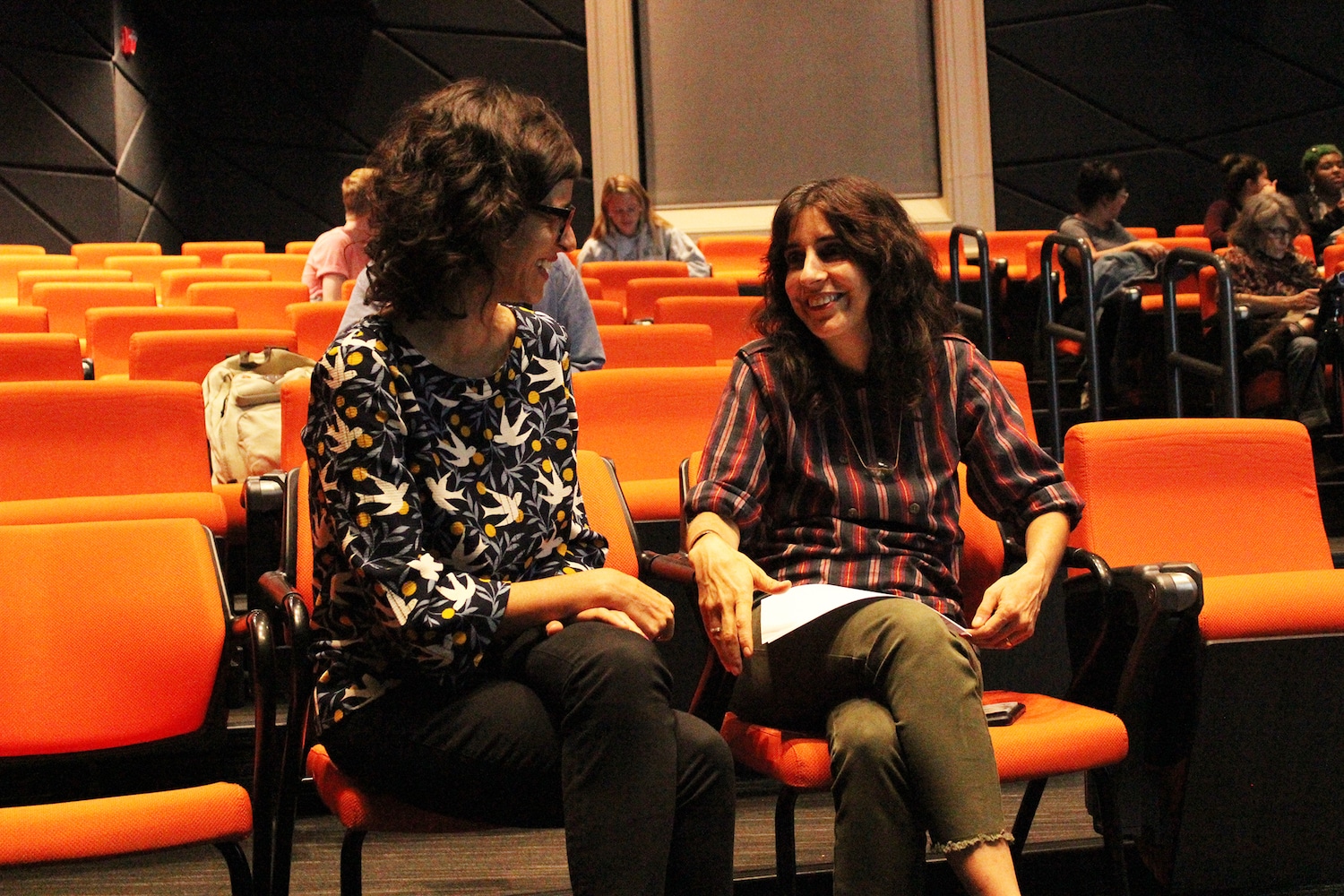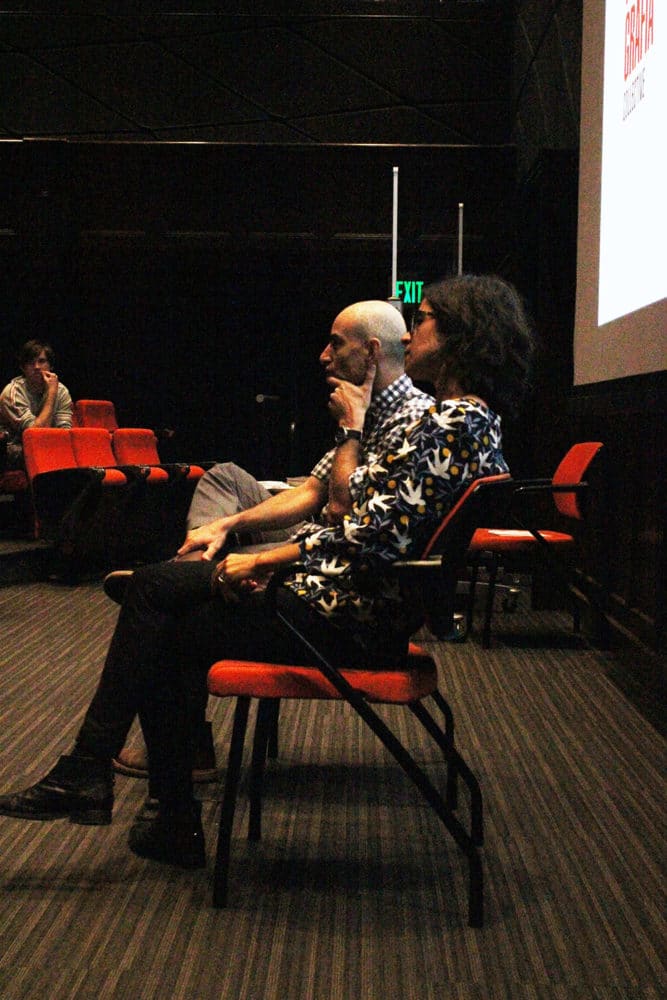
The Oxy Arts Speaker Series with Fonografia Collective took place in Choi Auditorium Sept. 24 and was followed by a question and answer session with the photojournalists behind the exhibit –– Ruxandra Guidi and Bear Guerra. Following the Sept. 13 opening of “South of Fletcher: Stories from the Bowtie” in Weingart Gallery, Oxy Arts hosted Fonografia Collective as a part of its 2018–2019 Speaker Series. The discussion began with Guidi and Guerra talking about some of their previous projects in LA and abroad, highlighting their overarching creative process as a team. The married photojournalists then transitioned the discussion to the current Weingart exhibit and the implications behind what is happening in the Bowtie region of LA. The artists define the Bowtie region as four neighborhoods that are rapidly gentrifying: Atwater Village, Cypress Park, Glassell Park, and across the river, Elysian Valley.
According to Guidi, the Collective wanted to have this event at Occidental College because it is located in the Northeast LA community –– a place that is also rapidly gentrifying. Since the city as a whole is constantly changing, Guidi said that she and Guerra wanted to implement these ideas within a more intimate discussion in the Northeast LA community.
“We try to cover the sides of things that aren’t covered enough in the media. Or take a little different angle on it,” Guerra said. “Typically [in the] media, like newspapers and some magazines, not a lot of time is given to exploring different sides of the story. There’s a very specific formula that’s followed [by journalists] in order to create balance.”
To highlight this theme of focusing on the people who are not usually covered in the media, Guidi used his projects in Latin America as an example. According to Guidi, the collective covered a story about how rising sea levels and erratic weather patterns off the coast of Panama have impacted indigenous communities to show how climate change affects people directly.
“So if we’re talking about a post-industrial site along the LA River, we wanted to stress that there are people who are connected to it,” Guerra said. “And so we hope that people who have historically been pushed out of their neighborhoods will hopefully have a voice in how their neighborhoods evolve.”
According to Guerra, he and his wife work together on projects and try to keep people front and center in their stories. They make a point to also include portraits of people in their work so viewers have a chance to spend time with the image and connect with the people. He said that people are the heart of any given story, and with that, he does not want the technical process to be the focus of the art.
“I actually want my process to fade into the back for a little bit, so people aren’t thinking so much about how I made the photographs, as they are about what’s in the photographs,” Guerra said.
One person in the discussion asked about Guerra and Guidi’s choice to use only black and white photographs in the exhibit. Guerra said black and white is one way to create a more direct line for people to engage in the subject matter. Additionally, Guerra said color can be distracting because the color itself has the ability to become a character in the way someone tells a visual story.
“I mentioned in the talk the other day that one of my favorite photographers, Robert Frank, said that black and white is the color of hope and despair, and that was definitely in the back of my mind in this project,” Guerra said.
Choi Auditorium was nearly full with students and faculty, including Dilin Massand (sophomore). According to Massand, the black and white color scheme also stood out to him. Specifically, the contrast between both shades draws attention to the different components of the Bowtie.

“The aesthetic of the pictures was really interesting,” Massand said. “There was this one person during the question and answering section who asked why they [the photojournalists] chose to do the project in black and white, and just seeing how they captured these areas or these people in black and white was powerful in a weird way and really brought out the narrative of each individual picture.”
According to Massand, before the discussion, the subject matter was not something he felt connected to. After the discussion, however, he expressed a desire to visit the exhibit in Weingart Gallery, because he now understands that the Bowtie will not be the same place it once was.
“It was interesting to see people make something or do something about this place in LA. It seemed like such an insignificant thing, but to them, it means a lot. It’s cool to see that with some people, those types of things really do mean a lot,” Massand said.
This discussion is not the only way Fonografia Collective will connect to the Occidental community. According to Diplomacy and World Affairs professor Anthony Tirado Chase, Guidi and Guerra will be leading his Cultural Studies Program class, “Expulsions: Un/documented Migrants, Refugees, and the Stateless,” on a site visit to the Bowtie.
“It’s important that our students understand that expulsions are taking place in sites both near and far; indeed, that they are part of the everyday fabric of our society’s political economy,” Chase said.
There will be two off-campus opportunities to further engage with the Bowtie. There will be a Bowtie Tour and Campfire Oct 14. with Bob Ramírez, a former Southern Pacific Railroad employee. Additionally, there will be a Panel Discussion with Fonografia Collective and an array of urban planners and designers, including LA Chief Design Officer Christopher Hawthorne Oct. 17.
![]()


































